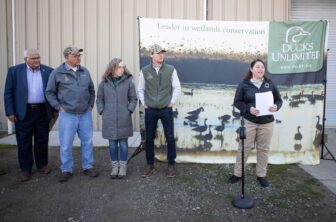
Lake Erie wetland. Image: Michigan United Conservation Clubs.
By Anastasia Pirrami
Toxic algal blooms in western Lake Erie have begun to affect not only aquatic life but human economics.
A Michigan State University study estimates that up to $5.9 million annually in economic activity is lost in Michigan’s small portion of Lake Erie because of canceled angling trips due to harmful algal blooms.They are caused by agricultural and excess fertilizer runoff.
The study was commissioned by Michigan United Conservation Clubs.
”Twenty-one thousand fishing trips were canceled in 2019,” said Nick Green, the conservation club’s director of communications and marketing.
He said the lost revenue is related to gas, lodging, food and other things connected to fishing and boating.
Toxic blooms damage boating and other water equipment because as algae photosynthesize, it produces oxygen, which causes corrosion to the metal surfaces.
In the summer, surface water reaches high temperatures and that is when algae can form. It becomes a problem when the blooms are bigger and more toxic, which is caused by runoff and other pollutants, said Kali Rush, regional biologist at Ducks Unlimited.
As harmful algal blooms have a direct negative effect on wildlife and fish in Lake Erie, it can translate to an economic loss, said Rush.
“If you think about all of the fishing charters that go out in Lake Erie, most of those get canceled,” Rush said. “Beaches end up getting shut down and so there can be an economic loss there on some of these summer resorts on the lake.”
The Michigan United Conservation Clubs, a partner with Ducks Unlimited, focuses on monitoring and mitigating the conservation of recreational activities like hunting and fishing.

MUCC Executive Director, Amy Trotter, addresses members of the media and fellow stakeholders about harmful algal blooms and the impact it has on Lake Erie. Image: Michigan United Conservation Clubs.
Michigan United Conservation Clubs, works to secure funding for wetland restorations, Green said. The organization continues to study the economic impact so that it can provide numbers for policymakers to use to craft legislation/
“If we can say we’re losing X amount of dollars because of these blooms, that means a lot to small businesses, mom-and-pop shops, bait shops, and especially to those legislators whose constituents those are,” Green said.
The two conservation groups are finding that wetlands may be the natural solution to filtering the nutrients from the algae and protecting water.
By capturing some of the water and allowing soil and vegetation to uptake those nutrients instead of letting it go into the waterways, it will reduce the harmful algal blooms, Rush said.

Lake Erie wetland. Image: Michigan United Conservation Clubs.
By strategically placing wetlands in areas of lower elevation and at a point in the watershed where several different waterways are funneling through it, then the wetlands can absorb the water and hold it while the nutrients are then uptake by the vegetation.
To put simply, the water is going from the ag field through the wetland and then into a waterway which filters it, said Rush
“We like to call them, the kidneys of the landscape,” said Rush.
The positive recreational impacts of wetlands contribute to better habitat for fish and animals, and then for hunters as well, said Green.
Toxic algal blooms are being studied across the United States, and Lake Erie is going to continue to be in the spotlight as we move forward, he said.